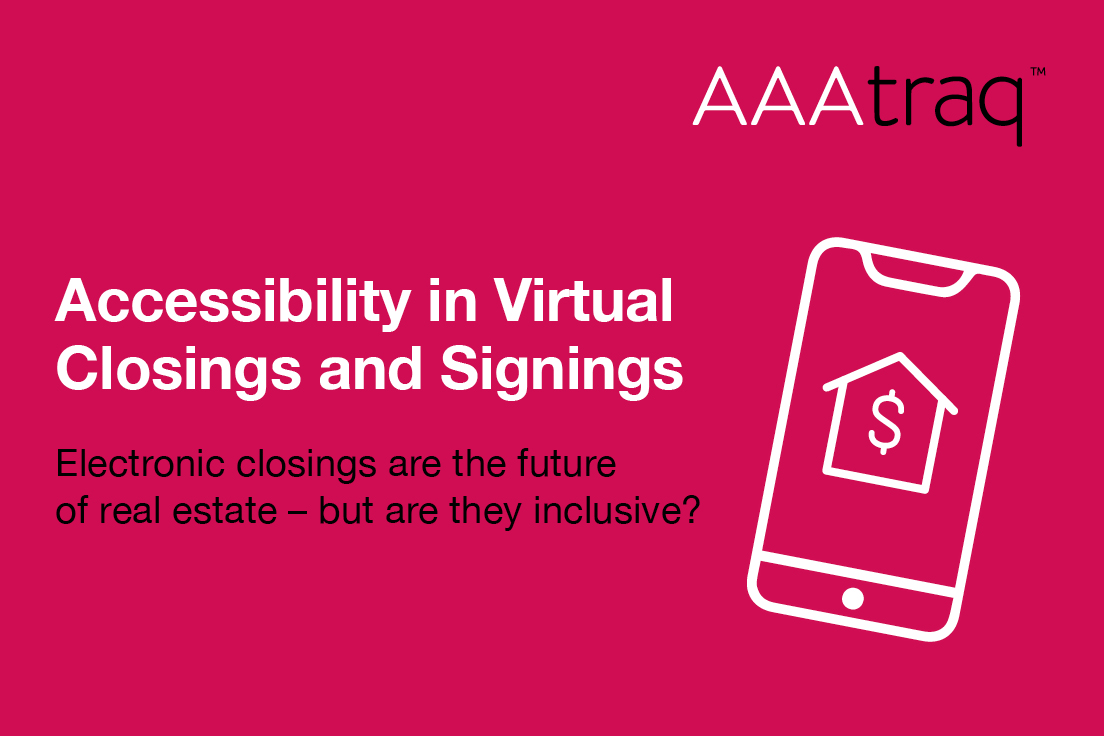Accessibility in Virtual Closings and Signings
Jun 15 2022
While many of the recent technological developments in articles discussed by AAAtraq were brought about by about the reliance on digital during quarantine periods of the COVID-19 pandemic, the use of technology to engage in virtual closings in real estate and esignatures had already begun to ingratiate itself into modern real estate practice.
Electronic closings (eClosings) are the future of real estate. As the world globalizes, and the world digitizes, it is reasonable to assume that real estate buyers and sellers won’t always be in a mutually convenient space to conduct an in-person closing. To combat this issue, the real estate market has developed ways to conduct closings through a virtual model. In fact, McKinsey said “The United States has seen a 20 percent increase in preference for contactless operations, with numerous industries adapting to this change.” As such, the models of contactless real estate operations are geared to reflect consumer preferences. The online closing process varies by jurisdiction, and regulatory allowances dictate the extent to which digital may be used in the closing process. There are three main formats of eClosings: Hybrid eClosings, In-Person Electronic Notarization (IPEN), and Remote Online Notarization (RON).
Hybrid Closings
Hybrid closings are a form of eClosingthat enables representatives from each party to complete a portion of the necessary documents in a digital format. Unlike other forms of eClosings, the hybrid closing requires that all parties be in person to electrically sign (eSign) and electrically notarize (eNotarize) some digital documents. Other documents, thus necessitating the in-person format, still require a wet (physical) signature and notarization on other types of documents.
In-Person Electronic Notarization (IPEN)
Similarly to a hybrid eClosing, the in-person electronic notarization format necessitates an in-person, face to face meeting between the borrowers and a notary public. Unlike the hybrid format, IPEN does not require that any document be signed with a wet signature. All documents are electronically signed and notarized using digital technology. This format, depending on the jurisdictional allowances for remote online notarization (RON) may be the most flexible format afforded to the borrowers.
Remote Online Notarization (RON)
As of January 2022, 35 states had permanent legal allowances for Remote Online Notarization (RON). RON allows borrowers, notaries, and other parties to complete the entirety of the closing process through a virtual modem. Every document is eSigned and eNotarized by parties who are present through a two-way audio and visual piece of technology that operates over the internet.
Accessibility of eClosings
eClosings pose several challenges to accessibility for disabled individuals. First and foremost, the process itself is incredibly individualized and dependent upon the documents and their respective formatting. All documents must be accessible to screen readers, and such documents should not be PDFs for signatures. PDFs, by nature, are inherently inaccessible, as they provide little to no adaptability/access functions beyond what is presented on the screen. Traditionally, the user’s ability to engage with the document on a website is severely limited when using a PDF, as functions such as zoom, speech to text, and editability are often inaccessible in PDF documents. As such, many sites favor using HTML content, allowing the user to engage with content on the website and utilize key accessibility functions.
Subscribe to AAAtraq and enjoy complete cover and peace of mind
